HTML
-
激光选区熔化技术(selective laser melting,SLM)是一种自下而上累加材料的制造方法,最早由德国Fraunhofer激光技术研究所提出,是快速原型技术的一种。相对于传统加工工艺,SLM技术对被加工零件的形状没有要求, 在保证零件良好性能的基础上缩短了加工周期、提高了生产效率;对市场需求响应快等特点,已被广泛应用于汽车制造行业、快速模具制造、航空航天和医学等多个领域[1-2]。将快速原型技术应用到电火花加工用的工具电极的制备中,有两种方法:一是间接法,即通过快速原型技术得到电极芯模,再通过电铸、喷涂等方法制作出工具电极;二是直接法,即利用快速原型技术制造出工具电极原型件,再经过后处理得到工具电极。其中,间接法工序较多、加工时间较长且电极损耗率较高,而直接法的加工材料主要是一些多组分金属粉末[3-4]。学者对激光烧结纯铜粉末的研究很少。本文中对纯铜粉末进行了SLM实验,研究了铺粉厚度为0.05mm时,工艺参量对成形件尺寸精度的影响。
SLM成形的误差来源主要有:数据处理误差、设备误差、加工误差等[5]。本文中不考虑其它误差,主要从改变工艺参量的角度出发来提高SLM铜粉成形件尺寸精度。此外,由于激光选区熔化金属时,需要先在基板上打印支撑,而支撑又在取出零件时作为电火花线切割的加工余量,导致测量成形件竖直方向(z方向)尺寸较为困难。因此,本文中主要研究工艺参量对成形件长(x方向)、宽(y方向)尺寸精度的影响。
-
实验材料为纯度超过99.96%的铜粉末。粉末颗粒的直径为15μm~53μm,平均粒度为35μm,熔点约为1084℃。实验设备采用西安铂力特激光成形技术有限公司生产的S300金属打印机,如图 1所示。打印机配备光纤激光器,最高扫描速率达7000mm/s的振镜扫描系统,最小铺粉厚度为15μm的铺粉系统,供粉仓,回收仓以及大颗粒和碳化物清理系统。烧结粉末所用的基板为上表面粗糙度Rz不超过0.8μm、下表面粗糙度Rz不超过1.6μm的钛合金板。打印时基板初始温度为40°,成形仓内氧含量低于0.06%,成形仓压力约为3.5kPa,打印过程在氩气保护下进行。
-
SLM的成形机制是粉体完全熔化机制,即在高能激光束的作用下,熔池位置的粉末被急剧加热并迅速熔化后形成熔池,激光束继续移动,熔池迅速冷却凝固。其成形原理是:先在计算机上建立3维模型,然后将该模型“切片”,利用激光束烧结粉末,使烧结成型的固化层逐层叠加生成所需形状的零件[6-7]。其整个工艺过程包括3维模型建立及数据处理、铺粉、烧结等。图 2为SLM成形原理图。
-
为了减少实验次数、缩短实验周期,采用正交实验法设计实验。实验因素有:激光功率、扫描速率、扫描间距和扫描路径,前三者取四水平,扫描路径取三水平。因素水平表如表 1所示。
levels factors laser power/W scanning speed/(mm·s-1) hatch space/mm scanning path 1 360 600 0.05 zigzag 2 380 750 0.06 orthogonal 3 400 900 0.07 spiral 4 420 1050 0.08 Table 1. Parameters of orthogonal experiment
实验中打印了16个尺寸为8mm×8mm×5mm的长方体试件,如图 3所示。使用三坐标测量机测量试件长宽尺寸。为减小测量误差,每个试件各测量5次后取其平均值,最后计算出尺寸绝对误差。使用SPSS 17.0设计混合正交实验表,正交实验和极差分析结果如表 2所示。表 2中, δx,δy表示x,y方向上的尺寸绝对误差,单位为mm;Ki为各因素各水平下尺寸绝对误差的数据和,i=1,2,3,4。Ki为Ki的均值;R为Ki的极差,R′为R的调整值。根据结果得到了各因素与尺寸绝对误差的关系趋势图,分析了各因素对尺寸精度的影响规律。从表 2发现,x方向的尺寸绝对误差总是比y方向的大,这是由于扫描振镜在x/y轴上的偏转误差造成的。
No. laserpower scanningspeed hatch space scanning path absolute error of size/mm δx δy 1 2 2 2 2 0.4673 0.3394 2 2 4 3 1 0.3374 0.2779 3 1 2 3 1 0.3856 0.3298 4 3 3 3 3 0.3875 0.3123 5 1 1 1 1 0.5449 0.3669 6 1 4 2 3 0.3141 0.2819 7 3 1 2 1 0.5015 0.3517 8 1 3 4 2 0.3520 0.2742 9 4 3 2 1 0.3952 0.3344 10 2 3 1 1 0.4559 0.3467 11 3 4 1 2 0.4118 0.3300 12 2 1 4 3 0.4368 0.3370 13 4 1 3 2 0.4831 0.3479 14 3 2 4 1 0.3692 0.3172 15 4 4 4 1 0.3456 0.2785 16 4 2 1 3 0.5133 0.3574 K1/mm x direction 1.5966 1.9663 1.9259 3.3353 y direction 1.2528 1.4035 1.4010 2.6051 K2/mm x direction 1.6974 1.7354 1.6781 1.7142 y direction 1.3010 1.3438 1.3376 1.2915 K3/mm x direction 1.6700 1.5906 1.5936 1.6517 y direction 1.3112 1.2676 1.2679 1.3188 K4/mm x direction 1.7372 1.4089 0.5036 y direction 1.3182 1.2673 1.1917 K1/mm x direction 0.3991 0.4916 0.4815 0.4169 y direction 0.3132 0.3509 0.3503 0.3256 K2/mm x direction 0.4244 0.4339 0.4195 0.4286 y direction 0.3253 0.3360 0.3269 0.3229 K3/mm x direction 0.4175 0.3977 0.3984 0.4129 y direction 0.3278 0.3169 0.3170 0.3297 K4/mm x direction 0.4343 0.3522 0.3759 y direction 0.3300 0.3168 0.3017 R/mm x direction 0.0352 0.0674 0.1056 0.0137 y direction 0.0168 0.0339 0.0486 0.0068 R′/mm x direction 0.0317 0.0607 0.0950 0.0123 y direction 0.0151 0.0305 0.0437 0.0061 Table 2. Orthogonal experimental results
1.1. 实验材料及设备
1.2. 实验原理
1.3. 实验方法、数据及结果
-
根据表 2中的数据绘制激光功率与尺寸绝对误差趋势图,如图 4所示。发现绝对尺寸随着激光功率的增大而增大。激光功率较低时,粉体吸热较少,只有少数金属粉末被熔化,产生的液相也少,形成的熔池直径和熔道宽度小,所以尺寸误差小[8]。激光功率增大后,粉末吸收过多热量,产生较多的液相,熔体表面张力和粘度降低,热影响区大,形成的熔池尺寸较大,液相向周围未熔化区域蔓延,粉末颗粒间的粘结力增强,导致熔池周围较多的金属粉末被粘附在熔池周围,造成大的尺寸误差。同时,大的激光功率使粉末被烧结时“飞溅”且烧结过程中产生较多“黑烟”,也会导致成形件绝对误差大[9-10]。
在其它工艺参量不变的情况下,降低激光功率可以减小成形件的尺寸绝对误差。小的激光功率还可以降低“第一线扫描球化”现象,保证下一层的铺粉质量[11]。但是,激光功率不能过小。当激光功率过小时,激光能量不能熔化足够的金属粉末,没有足够的液相浸润粉末,不能形成连续熔道,甚至使成形件内部出现裂纹[12]。
-
扫描速率与尺寸绝对误差的关系趋势图如图 5所示。可以发现尺寸绝对误差随扫描速率的增大而减小。扫描速率决定了激光束与粉体的接触时间。当扫描速率较低时,激光束与金属粉层表面的接触时间相对较长,粉末颗粒吸收较多热量并被熔化,形成足够的液相并向周围蔓延,导致熔池尺寸大,熔道较宽,尺寸误差大。扫描速率增加后,激光束与金属粉层表面的接触时间缩短,粉体熔化后,液相还来不及向四周蔓延就迅速冷却凝固,导致熔池尺寸小,熔道较窄,尺寸误差小[13-14]。
-
扫描间距与尺寸绝对误差关系趋势图如图 6所示。发现绝对尺寸随扫描间距的增大而减小。激光束按扫描路径运动,熔池冷却形成熔道,相邻熔道搭接,形成单一烧结层,如图 7所示。扫描间距主要影响相邻熔道之间的搭接程度[15]。当扫描间距较小时,相邻熔道之间的搭接面积较大,相邻熔道之间产生能量堆积现象,能量相对集中,能熔化较多金属粉末,熔池深度和宽度大,吸附的半熔化金属粉末也多,造成的尺寸绝对误差大。当扫描间距较大时,相邻熔道之间搭接面积较小,热量积累相对较少,被熔化的粉末少,形成的熔池尺寸小且基本不吸附金属粉末,所以尺寸绝对误差较小[16]。
在其它工艺参量不变的情况下,可以通过增大扫描间距来减小SLM成形件的尺寸绝对误差。但是,并不是扫描间距越大越好。从图 7可以看出,SLM成形铜粉时,相邻熔道必须能够搭接在一起,即必须保证相邻两熔道之间有一定的搭接率,否则零件无法顺利成形[17]。
-
扫面路径与尺寸绝对误差关系趋势图如图 8所示。本次实验中采用3种不同的扫描路径,分别是:zigzag, orthogonal, spiral。扫描过程为层错扫描,相邻层之间偏转67°。单一烧结层的成形是一个由“点”连接成“线”,由“线”搭接成“面”的过程。熔池是“点”,扫描路径是“点”的连接路径。熔池尺寸主要受熔池内粉末吸收的热量决定,层错扫描可以使相邻层上的扫描路径之间有一定的偏转角度,避免能量集中,使熔池吸收的能量没有明显差异,所以,不同扫描路径对尺寸绝对误差的影响没有明显差别[18-19]。
-
由以上分析可知,要获得尺寸精度好的烧结件,需要在合适范围内选择激光功率、扫描速率、扫描间距。由于单一的参量并不能全面反映所有问题,因此,将以上各因素结合,用体能量密度综合表达各工艺参量[20]。体能量密度表示单位时间内单位体积上能量输入的多少,单位为J/mm3,计算公式如下:
式中,E是体能量密度,P是激光功率,v是扫描速率,s是扫描间距,h是铺粉厚度。将表 2中数据代入(1)式计算,结果如表 3所示。
No. E/(J·mm-3) δx/mm δy/mm 1 168.89 0.4673 0.3394 2 103.40 0.3374 0.2779 3 137.14 0.3856 0.3298 4 126.98 0.3875 0.3123 5 240.00 0.5449 0.3669 6 114.28 0.3141 0.2819 7 222.22 0.5015 0.3517 8 100.00 0.3520 0.2742 9 155.56 0.3952 0.3344 10 169.78 0.4559 0.3467 11 152.38 0.4118 0.3300 12 158.33 0.4368 0.3370 13 175.00 0.4831 0.3479 14 133.33 0.3692 0.3172 15 100.00 0.3456 0.2785 16 224.00 0.5133 0.3574 Table 3. Absolute error of sizes under different energy densities
根据表 3绘制散点图,发现体能量密度与绝对误差呈近似的线性关系,并对其进行线性拟合,结果如图 9所示。
由图 9可以看出,尺寸绝对误差随体能量密度的增大而增大。体能量密度决定了能量输入的多少,过多的能量输入导致烧结温度过高,产生液相较多,增加球化趋势,增大了尺寸绝对误差。虽然可以通过降低体能量密度的方法来减小尺寸绝对误差,但是体能量密度也不能过小,体能量密度过低时,会导致烧结失败(如图 10所示)。当体能量密度过小,为100.00J/mm3时,层间烧结质量较差。随着体能量密度增大,烧结质量逐渐提高。图 11为不同体能量密度下的层间形貌。图 11c为体能量密度224.0J/mm3条件下层间形貌图,与图 11a和图 11b相比较可以看出,图 11c的层间组织比较均匀致密。
2.1. 激光功率对尺寸绝对误差的影响
2.2. 扫描速率对尺寸绝对误差的影响
2.3. 扫描间距对尺寸绝对误差的影响
2.4. 扫描路径对尺寸绝对误差的影响
2.5. 体能量密度对尺寸精度的影响
-
(1) 由正交实验可知,在因素水平范围内,影响SLM铜粉成形件尺寸精度因素的主次顺序为:扫描间距 > 扫描速率 > 激光功率 > 扫描路径。获得最小尺寸绝对误差的工艺参量组合为:激光功率360W,扫描速率1050mm/s,扫描间距0.08mm,扫描方式选择spiral。成形件尺寸绝对误差均为正值,为成形件后处理提供机加工余量。
(2) 通过分析在水平范围内各因素对尺寸绝对误差的影响规律,初步提出激光选区熔化纯铜粉末时工艺参量的选择依据。
(3) 用体能量密度综合表示各工艺参量,得到了其与尺寸绝对误差的线性关系函数。选择小的体能量密度获得较小尺寸绝对误差的同时会牺牲层间烧结质量。在实际工作中,需考虑其它因素进行合理的参量配置。

 Map
Map



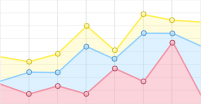
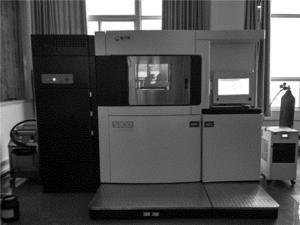


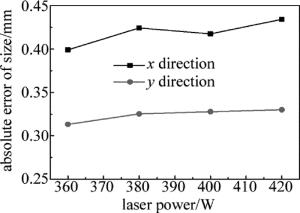
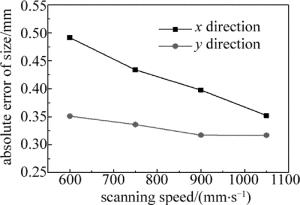

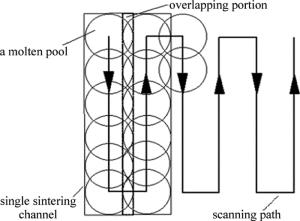
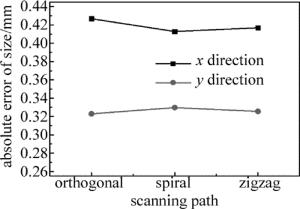
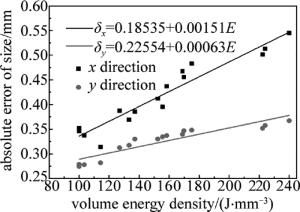
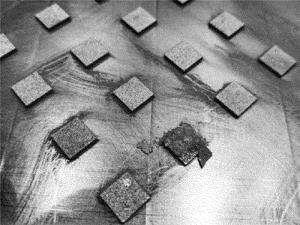

 DownLoad:
DownLoad:









